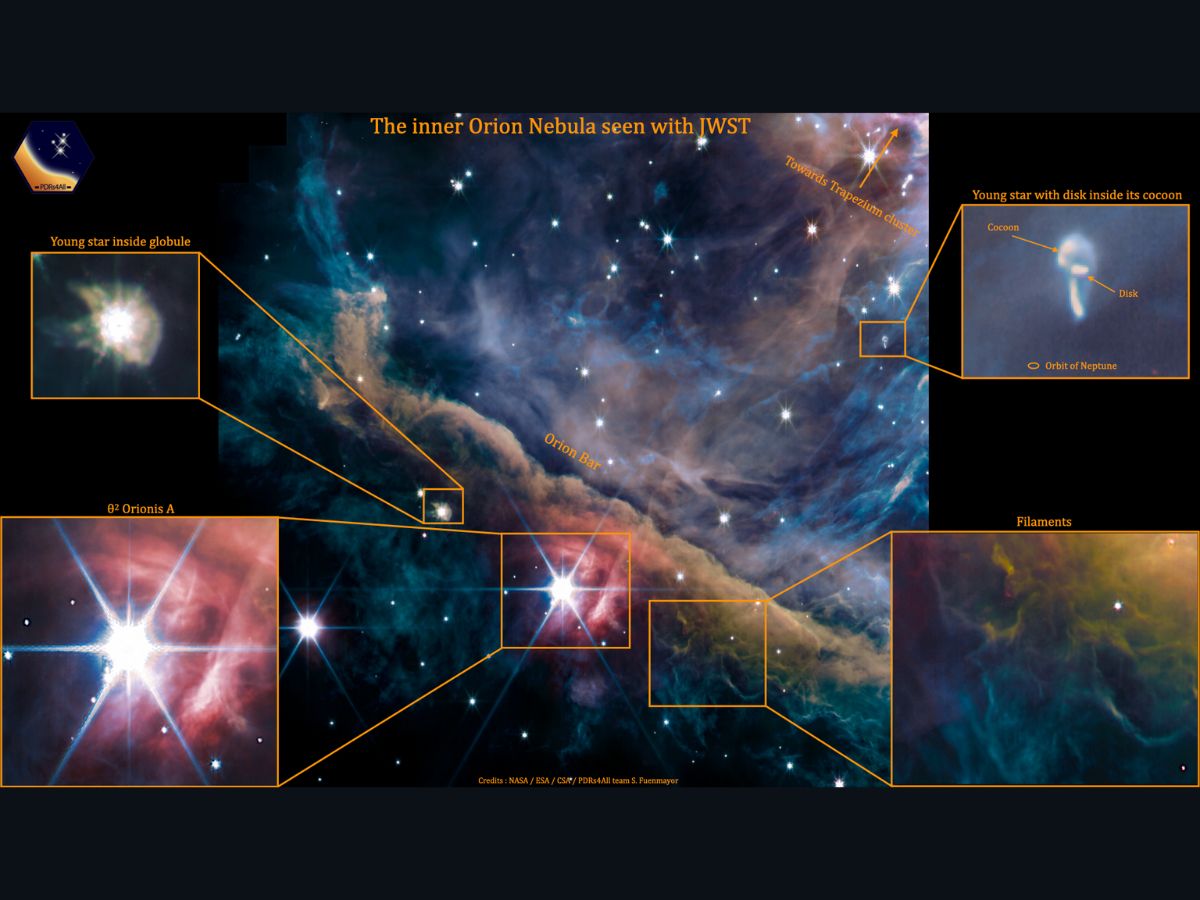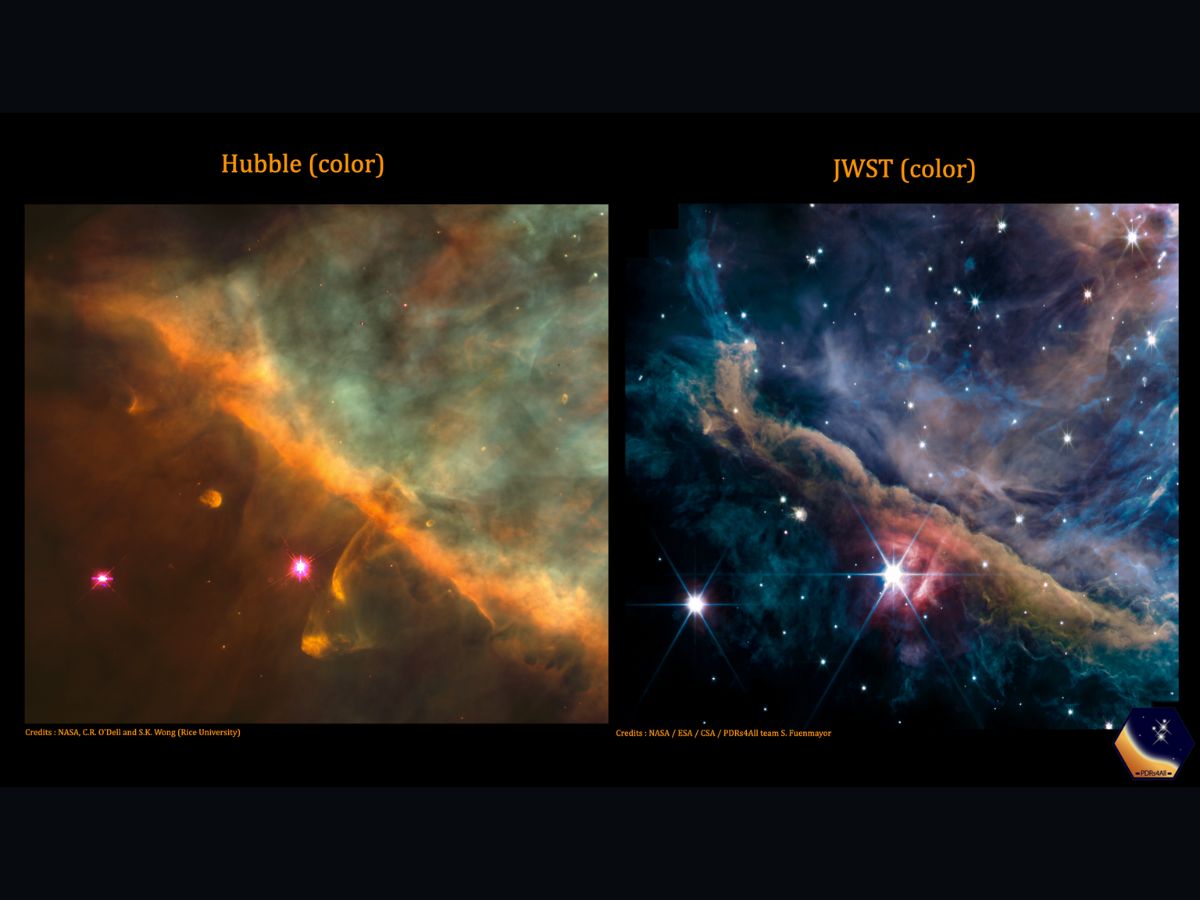James Webb Space Telescope Captures Inner Region Of Orion Nebula. See PICS
James Webb Space Telescope's Near-Infrared Camera instrument captured the Orion Nebula using several filters. The Orion Bar, the most prominent region in the composite image, is a wall of dense gas.

NASA's James Webb Space Telescope (JWST) has captured breathtakingly beautiful images of the Orion Nebula. The pictures reveal scattered starlight, ionised gas, molecular gas, hydrocarbons, and dust. Webb's Near-Infrared Camera (NIRCAM) instrument captured the Orion Nebula using several filters. The Orion Bar, the most prominent region in the composite image, is a wall of dense gas and dust that runs from the top left to the bottom right in the image, and contains the bright star θ2 Orionis A. The inner region of the Orion Nebula, captured by the world's most powerful telescope, is illuminated by a group of hot, young massive stars. These hot, young massive stars are known as the Trapezium Cluster. The cluster is located just off the top right of the image.
What Webb’s Images Of The Orion Nebula Mean
The Trapezium Cluster emits a strong and harsh ultraviolet radiation which creates a hot, ionised environment in the upper right. The radiation slowly erodes the Orion Bar away. The dense bar offers a shielded environment in which molecules and dust can survive longer.
However, the surge of stellar energy sculpts a region that displays an incredible richness of filaments, globules, and young stars with disks and cavities.
Young Star With A Disk Inside Cocoon

The above picture is a close-up image which shows a young star with a disk inside its cocoon. The planet-forming disks of gas and dust around the young star are being dissipated or "photo-evaporated" due to the strong radiation field of nearby stars of the Trapezium creating a cocoon of dust and gas around them. According to PDRs4All, a JWST Early Science Release Program, almost 180 of the externally illuminated photo-evaporating disks around young stars, also known as Proplyds, have been discovered in the Orion Nebula. Proplyd is short for ionised protoplanetary disk. It is an externally illuminated photo-evaporating protoplanetary disk around a young star.
The largest known proplyd in the Orion Nebula is HST-10. Inside the image of the Orion Nebula, the orbit of Neptune has been shown for comparison.
ALSO READ: James Webb Space Telescope Unveils 'Never-Before-Seen' Stars In Tarantula Nebula
Filaments In The Nebula
The image is rich in filaments of different sizes and shapes, including thin, meandering filaments that are especially rich in hydrocarbon molecules and molecular hydrogen.
The brightest star in Webb's image of the Orion Nebula is θ2 Orionis A. The star is just bright enough to be seen with the naked eye from a dark location on Earth. The red glow in the immediate surroundings of the star is due to stellar light that is reflecting off dust grains.
ALSO READ: Astronomers Bewildered By Mysterious Rings In New James Webb Space Telescope Image
Young Star Inside Natal Cloud
A young star is present inside the globule. Dense clouds of gas and dust collapse into stellar embryos when they become gravitationally unstable. The stellar embryos gradually grow more massive until they can start nuclear fusion in their core. Then, they start to shine. According to PDRs4All, a young star is still embedded in its natal cloud.
Comparison of the images of Orion Nebula captured by JWST and Hubble Space Telescope

Both the JWST and the Hubble Space Telescope have captured the inner region of the Orion Nebula. Hubble's image is dominated by emission from the hot ionised gas. The image highlights the side of the Orion Bar which is facing the Trapezium Cluster. The Orion Bar is seen at the top right of the image.
ALSO READ | Listen In: A New, Immersive Way To Explore NASA James Webb Space Telescope Images, With Sound
Webb's image also shows the cooler molecular material that is slightly further away from the Trapezium Cluster. The sensitive infrared vision of the world's most powerful telescope can furthermore peek through thick dust layers and see fainter stars, allowing scientists to study what is happening deep inside the nebula.
Comparison of images of the Orion Nebula captured by JWST and Spitzer

Both the JWST and the Spitzer Space Telescope have captured the inner region of the Orion Nebula. According to PDRs4All, the images were recorded with a filter that is particularly sensitive to the emission from hydrocarbon dust that glows throughout the entire image. Spitzer's infrared array camera (IRAC) captured infrared light at 3.6 microns. JWST's NIRCam captured infrared light at 3.35 microns.
The comparison between the images captured by Webb and Spitzer strikingly illustrates how incredibly sharp JWST's images are in comparison to its infrared precursor, the Spitzer Space Telescope.
Webb has captured intricate filaments in the Orion Nebula. Also, Webb's sharp eyes allow everyone to better distinguish stars from globules and protoplanetary disks.
Bonus image captured by JWST

Detector A of Webb's NIRCam instrument captured the northern region of Orion Nebula during observation of the Orion Bar.






































